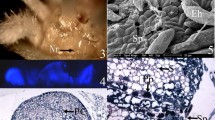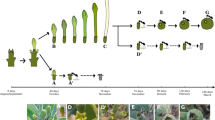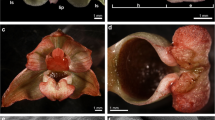Summary.
In an effort to gain a greater understanding of nectar production, we studied the dynamic mechanisms of starch accumulation and transformation and nectar transportation in the Cucumis sativus L. female flower. Starch, which is the main precursor of nectar, accumulates in the epidermis and underlying parenchyma, with the most active accumulation occurring in the parenchyma cells within 3 days prior to anthesis. Thereafter, the starch was successively hydrolyzed and the hydrolyte was transported from the amyloplasts to vacuoles, suggesting that amyloplasts and vacuoles are the centers of nectar production. In addition, we observed few plasmodesmata and the presence of invaginated plasmalemma and electron-dense material in the intercellular spaces, suggesting that the apoplast system is involved in nectar transportation in an ATPase-dependent fashion.
Similar content being viewed by others
Author information
Authors and Affiliations
Corresponding author
Additional information
Correspondence and reprints: College of Life Sciences, Peking University, Beijing, 100871, People’s Republic of China
Rights and permissions
About this article
Cite this article
Peng, YB., Li, YQ., Hao, YJ. et al. Nectar production and transportation in the nectaries of the female Cucumis sativus L. flower during anthesis. Protoplasma 224, 71–78 (2004). https://doi.org/10.1007/s00709-004-0051-9
Received:
Accepted:
Published:
Issue Date:
DOI: https://doi.org/10.1007/s00709-004-0051-9




